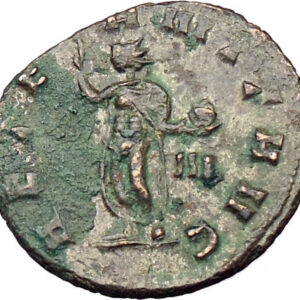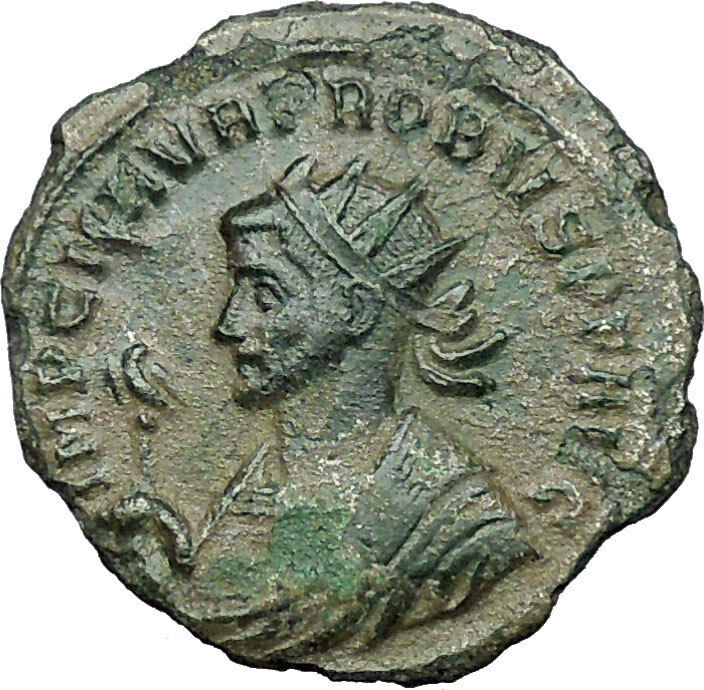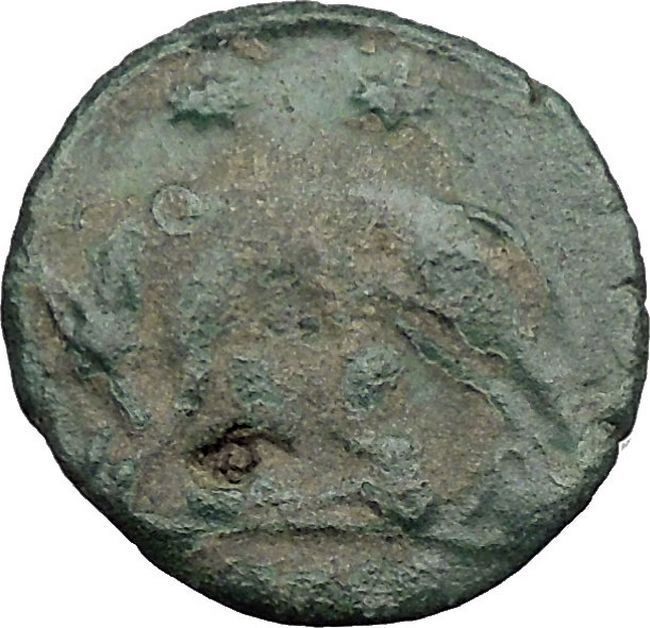|
Constans
–
Roman Emperor
: 337-350 A.D. –
Bronze AE3 20mm (2.26 grams) Treveri (Trier) mint, circa 348-350 A.D.
Reference: RIC VIII, 154, 228. Rare
DN CONSTANS P F AVG – Draped, diademed bust right.
FEL. TEMP. REPARATIO / TRS. – Nimbate Phoenix standing right pile of
rocks.
You are bidding on the exact item pictured,
provided with a Certificate of Authenticity and Lifetime Guarantee of
Authenticity.

A phoenix depicted in a book of
mythological creatures by
FJ Bertuch
(1747–1822).
|
In
Greek mythology
, a phoenix or phenix
(Greek:
φοῖνιξ phoinix) is a long-lived
bird that is cyclically regenerated or reborn. Associated with the
sun,
a phoenix obtains new life by arising from the ashes of its predecessor. The
phoenix was subsequently adopted as a symbol in
Early Christianity
. While the phoenix typically
dies by fire in most versions of the legend, there are less popular versions of
the myth in which the mythical bird dies and simply decomposes before being born
again. According to some legends, the phoenix could live over 1400 years before
rebirth. Herodotus
,
Lucan
,
Pliny the Elder
,
Pope Clement I
,
Lactantius
,
Ovid, and
Isidore of Seville
are among those who have
contributed to the retelling and transmission of the phoenix motif.
In the historical record, the phoenix “could symbolize renewal in general as
well as the sun
,
time, the
empire
,
metempsychosis
,
consecration
,
resurrection
, life in the heavenly
Paradise
,
Christ
,
Mary
,
virginity
, the exceptional man, and certain
aspects of Christian life”.
Etymology
The modern English noun phoenix derives from
Middle English
phenix (before 1150),
itself from
Old English
fēnix (around 750). Old
English fēnix was borrowed from Medieval Latin phenix, which is
derived from Classical Latin phoenīx. The Classical Latin phoenīx
represents Greek φοῖνιξ phoinīx.
In ancient Greece and Rome, the bird, φοῖνιξ, was sometimes associated with
the similar-sounding
Phoenicia
, a region famous for its production
of purple dye from conch shells. A late antique etymology offered by the 6th-
and 7th-century CE archbishop
Isidore of Seville
accordingly derives the name
of the phoenix from its allegedly purple-red hue. Because the costly purple dye
from Phoenicia was associated with the upper classes in antiquity and, later,
with royalty, in the medieval period the phoenix was considered “the royal
bird”.
In spite of these folk etymologies, with the deciphering of the
Linear B
script in the 20th century, the
original Greek φοῖνιξ was decisively shown to be derived from
Mycenaean Greek
po-ni-ke, itself open to
a variety of interpretations..
Relation to the
Egyptian benu
Classical discourse on the subject of the phoenix points to a potential
origin of the phoenix in
Ancient Egypt
. In the 19th century scholastic
suspicions appeared to be confirmed by the discovery that Egyptians in
Heliopolis
had venerated the
benu
, a solar bird observed in some respects to
be similar to the Greek phoenix. However, the Egyptian sources regarding the
benu are often problematic and open to a variety of interpretations. Some of
these sources may have been influenced by Greek notions of the phoenix.
Appearance
The phoenix is sometimes pictured in ancient and medieval literature and
medieval art as endowed with a
nimbus
, which emphasizes the bird’s connection
with the sun. In the oldest images of phoenixes on record these nimbuses often
have seven rays, like
Helios
(the personified sun of
Greek mythology
). Pliny also describes the bird
as having a
crest
of feathers on its head, and
Ezekiel the Dramatist
compared it to a
rooster
.
Although the phoenix was generally believed to be colorful and vibrant, there
is no clear consensus about its coloration.
Tacitus
claims that its color made it stand out
from all other birds. Some thought that the bird had
peacock
-like coloring, and
Herodotus
‘ claim of red and yellow is popular
in many versions of the story on record. Ezekiel the Dramatist declared that the
phoenix had red legs and striking yellow eyes, but
Lactantius
said that its eyes were blue like
sapphires
and that its legs were covered in
scales of yellow-gold with rose-colored talons.
In terms of size, R. Van den Broek, Herodotus, Pliny,
Solinus
, and
Philostratus
describe the phoenix as similar in
size to an eagle
, but Lactantius and Ezekiel the Dramatist
both claim that the phoenix was larger, with Lactantius declaring that it was
even larger than an
ostrich
.
Analogues
Scholars have observed analogues to the phoenix in a variety of cultures.
These analogues include the
Arabic
anqa
, the
Hindu
garuda
and
gandaberunda
, the
Russian
firebird
, the
Persian
Simorgh
, the
Turkish
Zümrüdü Anka, the
Tibetan
Me byi karmo, the
Chinese
fenghuang
, and the
Japanese
hō-ō
.
See also
-
Chol (bible)
, a Hebrew word sometimes
glossed as phoenix
Constans (Latin:
Flavius Julius Constans Augustus)
(c.323–350) was
Roman Emperor
from 337 to 350. He defeated his
brother
Constantine II
in 340, but anger in the army
over his personal life and preference for his barbarian bodyguards led the
general Magnentius
to rebel, resulting in the
assassination of Constans in 350.

Career
Constans was the third and youngest son of
Constantine the Great
and
Fausta
, his father’s second wife. He was
educated at the court of his father at
Constantinople
under the tutelage of the poet
Aemilius Magnus Arborius
.
On 25 December 333, Constantine I elevated Constans to the rank
of
Caesar
at
Constantinople
. Constans became engaged to
Olympias
, the daughter of the
Praetorian Prefect
Ablabius
, but the marriage never came to
pass.With Constantine’s death in 337, Constans and his two brothers,
Constantine II
and
Constantius II
, divided the Roman world between
themselves and disposed of virtually all relatives who could possibly have a
claim to the throne.The army proclaimed them
Augusti
on September 9, 337. Almost
immediately, Constans was required to deal with a
Sarmatian
invasion in late 337, over whom he
won a resounding victory.

Division of the Roman Empire among the Caesars appointed by
Constantine I
: from left to right,
the territories of
Constantine II
, Constans,
Dalmatius
and
Constantius II
. After the death of
Constantine I (May 337), this was the formal division of the Empire,
until Dalmatius was killed and his territory divided between
Constans and Constantius.
Constans was initially under the guardianship of Constantine II. The original
settlement assigned Constans the
praetorian prefectures
of
Italy and Africa
. Constans was unhappy with
this division, so the brothers met at
Viminacium
in 338 to revise the boundaries.
Constans managed to extract the prefecture of
Illyricum
and the
diocese of Thrace
,provinces that were
originally to be ruled by his cousin
Dalmatius
, as per Constantine I’s proposed
division after his death. Constantine II soon complained that he had not
received the amount of territory that was his due as the eldest son.
Annoyed that Constans had received Thrace and
Macedonia
after the death of Dalmatius,
Constantine demanded that Constans hand over the African provinces, which he
agreed to do in order to maintain a fragile peace. Soon, however, they began
quarreling over which parts of the African provinces belonged to
Carthage
, and thus Constantine, and which
belonged to Italy
, and therefore Constans. This led to
growing tensions between the two brothers, which were only heightened by
Constans finally coming of age and Constantine refusing to give up his
guardianship. In 340 Constantine II invaded Italy. Constans, at that time in
Dacia
, detached and sent a select and
disciplined body of his Illyrian troops, stating that he would follow them in
person with the remainder of his forces. Constantine was eventually trapped at
Aquileia
, where he died, leaving Constans to
inherit all of his brother’s former territories –
Hispania
,
Britannia
and
Gaul.
Constans began his reign in an energetic fashion. In 341-42, he led a
successful campaign against the
Franks
, and in the early months of 343 he
visited
Britain
. The source for this visit,
Julius Firmicus Maternus
, does not provide a
reason, but the quick movement and the danger involved in crossing the
channel
in the dangerous winter months suggests
it was in response to a military emergency, possibly to repel the
Picts
and
Scots
.
Regarding religion, Constans was tolerant of Judaism but promulgated an edict
banning pagan sacrifices in 341. He suppressed
Donatism
in Africa and supported
Nicene orthodoxy
against
Arianism
, which was championed by his brother
Constantius. Although Constans called the
Council of Sardica
in 343 to settle the
conflict, it was a complete failure, and by 346 the two emperors were on the
point of open warfare over the dispute. The conflict was only resolved by an
interim agreement which allowed each emperor to support their preferred clergy
within their own spheres of influence.
Death
In the final years of his reign, Constans developed a reputation for cruelty
and misrule.
Dominated by favourites and openly preferring his select
bodyguard, he lost the support of the
legions
who were also offended by his
homosexuality. In 350, the general
Magnentius
declared himself emperor at
Augustodunum
with the support of the troops on
the Rhine
frontier, and later the western provinces
of the Empire. Constans was enjoying himself nearby when he was notified of the
elevation of Magnentius.
Lacking any support beyond his immediate household, he was
forced to flee for his life. As he was trying to reach either Italy or Spain,
supporters of Magnentius cornered him in a fortification in
Vicus Helena
(now
Elne) in the
Pyrenees
, southwestern
Gaul
, where he was killed after seeking
sanctuary in a temple.
|











